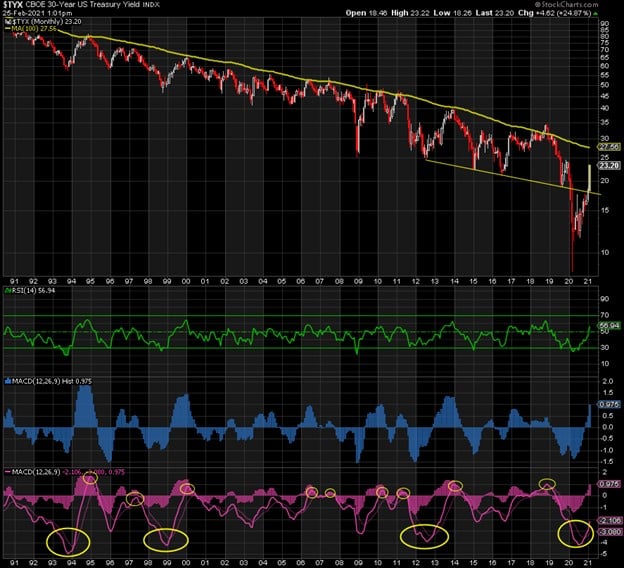The Case For Long-term Government Bonds, Gold, Silver and Commodities
Ten-year government bond yields have recently tripled from 50 basis points back on August 6, 2020, to about 1.50% today. There is a negative correlation between ten-year treasury bond yields and gold. The bond gold correlation is currently -0.80%. The negative correlation means that when yields rise, gold falls, and vice versa. The recent rise in bond yields and drop in gold prices confirms this as of 2-27-21.
However, look at the monthly chart of the 30-Year Treasury Yields below. Note that over the last 30-years, every time the 30-year Treasury bond yields hit their 100-Month Moving Average, yields declined, and correspondingly, 30-years bond prices increased.
Source: StockCharts.com
The current 30-year bond yield’s 100-Month Moving Average is approximately 2.75%. The current yield on 30-year bonds has been going up quickly and now stands at about 2.32%. The recent rise in long-term yields is also causing long-term treasury bond prices to fall.
However, with 30 years of history as a guide, it is reasonable to expect yields to go lower and long-term bond prices (and gold/silver) to go higher, especially if yields reach approximately 2.75-3.00%.
What will cause bonds (gold and silver) to go higher and bond yields to go lower? The Biden administration’s current $1.9 trillion stimulus plan. Also, business lockdowns, which weaken the economy, will require much more Fed stimulus in the future. Add the probable introduction of Universal Basic Income and Fed intervention is inevitable. The intervention will come in the form of the Fed printing new dollars to buy treasury bonds, providing the treasury enough dollars to fund the stimulus. When the Fed prints money and purchases treasury bonds, it increases the demand for bonds, raising bond prices while driving bond yields (interest rates) lower.
Without the Fed intervening by printing money to buy treasury bonds, the treasury would need to sell massive numbers of bonds in the market to finance the economic stimulus. Without the Fed’s artificial demand (printing money to buy treasury bonds), yields (interest rates) would go much higher. Substantially higher interest rates could result in government insolvency because of the annual interest cost alone on the current approximate $28 billion in government debt.
Of course, printing trillions of dollars reduces each current dollar’s purchasing power (inflation). Inflation is already rapidly rising; look at grocery prices, oil prices, commodity futures, health care, home prices, etc. Continued Fed intervention only means one thing for “real assets” like gold, silver, commodities, the mining companies, and (in my opinion) Bitcoin. They’re going to turn around and go higher along with long-term government bonds.
Not complete without disclosures pages.


